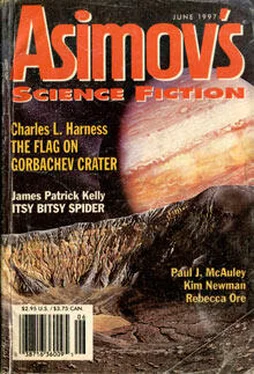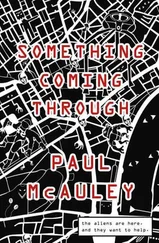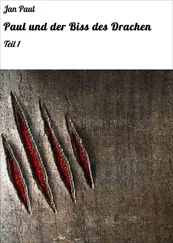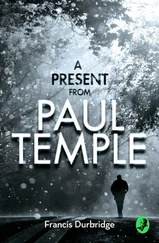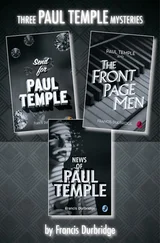Those two agents don’t tell me as much as I need to know, but I suspect that they don’t know what it is Mitchell is doing. I have an idea that he’s building something out in the desert that’ll bring those old times back again.
Driving out to Mitchell’s place takes a couple of hours. The route on the map he gave me is easy enough: south along Pearblossom’s two-lane blacktop, then over the concrete channel of the aqueduct that carries water taken from Washington State—did you see Chinatown? yeah, there— and up an unmade track that zigzags along the contours of the Piñon Hills and into a wide draw that runs back a couple of miles. The light in the draw is odd. Cold and purple, like expensive sunglasses. Either side of the road is nothing but rocks, sand, dry scrub, and scattered Joshua trees.
I start to feel a grudging sympathy for Agent Bissette. No matter how he hangs back, it’s impossible to tail a car out here without your mark knowing. I have the urge to wait for a dip that puts me momentarily out of his sight and swerve off into a patch of soft sand, sinking the rental like a boat in shallows, creating another unexplained mystery.
Mitchell’s place is right at the top of the draw, near the beginning of the tree line. In the high desert, trees grow only on the tops of the mountains. The FBI parks under a clump of stunted pines and lets me go on alone. I’m lucky they didn’t want me to wear a wire. They’ll just wait, and see if I can cope with Crazy Elliot. For them, it’ll be a boring afternoon, with maybe an exciting apprehension about nightfall.
Me, I’m going back to the Days of Sharp Focus.
The rye in the coffee has burned out and I’ve not touched the soup-warm beer on the passenger seat. I can feel the heat steaming the booze out of my brain. I’m going into this alone.
I get out of the rental, aware of Winter and Bissette watching me through the tinted windshield of their Lincoln Continental. Of Mitchell, there’s not a trace. Not even footprints or tire marks in the sandy track. I crouch down, and run a handful of warm sand through my fingers, making like an Indian tracker in some old Western while I ponder my next move.
There are tine-trails in the sand. The whole area has been raked, like a Japanese garden. I can imagine Mitchell working by night, raking a fanshaped wake as he backs toward the paved area I see a dozen yards away.
I walk across the sand, and reach the flagstones. This was the floor of a house that’s long gone. I can see the fieldstone hearth, and the ruts where wooden walls had been.
Beyond the stone is a gentle incline, sloping down maybe twenty feet, then leveling off. Down there, protected from sight, Mitchell has been building. I look at his paper, and see what he means. The FBI think it’s a circuit diagram, but it really is a map. Mitchell has made himself a maze, but there’s nothing on his map that shows me how to get through it.
I know now where the old timbers of the house have gone. Mitchell has cannibalized everything carriable within a mile, and some things I would have sworn you’d need a bulldozer at least to shift, but he must have had a few truckloads of chickenwire, wood, and just plain junk hauled out here. The archway entrance is a Stonehenge arrangement of two 1950s junkers buried hood-first like standing stones, with their tailfins and clusters of egg-shaped rear lights projecting into the air. A crosspiece made of three supermarket shopping carts completes the arch.
There are other old cars parked and piled in a curving outer wall, built on with wire and wood. And all over the place, sticking up through the sand, are sharp spars and spines that sparkle in the sun.
I know that glittery look, a glinting like the facets of an insect’s eye or 1970s eye makeup under fluorescent disco lights. It’s Mitchellite.
I walk up to the gateway and stop, careful not to touch the spars. They dot everything—stone, wood, metal—like some sort of mineral mold. Crusty little alien points that seem to be growing out of the ordinary Earth stuff. About ten years ago, a couple of crazy English physicists claimed you could use Mitchellite to get unlimited energy by cold fusion and end up with more Mitchellite than you started with, but they were debunked, defrocked, and for all I know defenestrated, and that was the end of it. But maybe they were right. It looks like the Mitchellite is transmuting ordinary stuff into itself.
There’s an iron crowbar, untouched by Mitchellite, propped against a stone. I pick it up, heft it in my hands. It has a good weight. I always felt better with a simple tool, something you could trust.
Planks are set between the half-buried cars, a path into the interior of the maze. They are pocked with Mitchellite spars that splinter the rotten wood from the inside. I smash down with the poker and split a plank, scraping away bone-dry wood fragments from the Mitchellite nerve-tangles that have been growing inside, sucking strength from the material.
It looks fragile, but it doesn’t crumple under my boots.
On the other side of the arch hangs a shower curtain that leaves a three-foot gap beneath it. I push it aside with the crowbar and step into the maze.
The structure is open to the sky, mostly. The walls are of every kind of junk, wood, lines of rocks or unmortared concrete blocks, even barbed wire, grown through or studded with Mitchellite. A few yuccas rise up from the maze’s low walls, their fleshy leaves sparkling as if dusted with purplish snow. The floor is made of Mitchellite-eaten planks. There are stretches of clean, unmarked sand. But by each of them is propped a rake, for obscuring footprints. By the first rake is a pane of glass in the sand, and in the hollow under the glass is a handgun wrapped in a plastic baggie, and a handwritten note. In case of F(B)IRE smash glass. So that’s what the crowbar is for. I leave the gun where it is and turn and stare at the maze again.
After a while I fish out the map and look at it. It takes me a while even to work out where I am, but with a creepy chill I realize I’m standing on the spot where Mitchell has drawn a stick figure. In the center of the map is a white space, where there’s another, bigger stick figure. Dotted throughout are smaller figures, drawn in red. I know what they’re supposed to be. Some are drawn over black lines that represent walls.
I call out Mitchell’s name.
The maze funnels my own voice back to me, distorted and empty.
“Ray, come on, what are you waiting for?”
It was obviously a doorway. Mitchell bent down low—the round opening was the creatures’ size—and squeezed into the ship.
I hesitated, but thought of Susan, and the things that had taken her.
“I’m coming, Mitchell.”
I followed the geologist. Inside, was another world.
“I’m coming, Mitchell.”
I know at once what he’s done. This isn’t really a maze. It’s a model, twice as big again as the real thing, of the aliens’ ship.
My knees are weak and I’m shaking. I’m back on the mandala path. I’m above myself and in myself, and I know where to go. I know the route, just as I know the ache that sets into my knees after a minute, an ache that grows to a crippling pain. Just as I remember finding Susan. And finding out later what they’d done to her.
Mitchell took the lead, that time. I followed, forgetting Nyquist chicken-heartedly frozen at the entrance, not daring to go further.
Remembering, I follow Mitchell’s lead again. Around and inward, a spiral across a DNA coil or a wiring diagram, a bee-dance through catacombs. The route is a part of me.
The deeper inside the maze I get, the more Mitchellite there is. The original wood and stone and wire and concrete has been almost completely eaten away. Purple light glitters everywhere, dazzling even through my sunglasses. Without them, I’d be snow-blind in a minute.
Читать дальше
